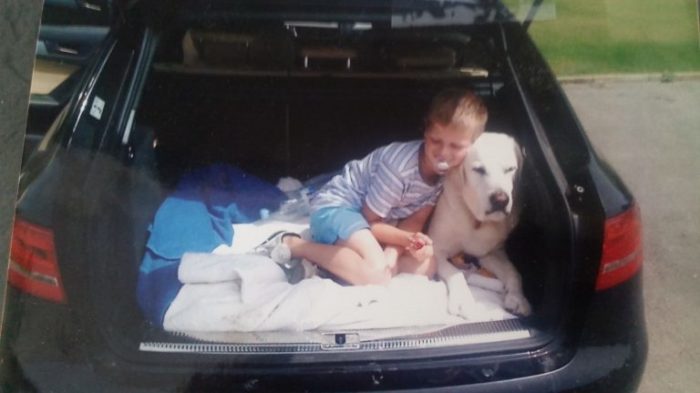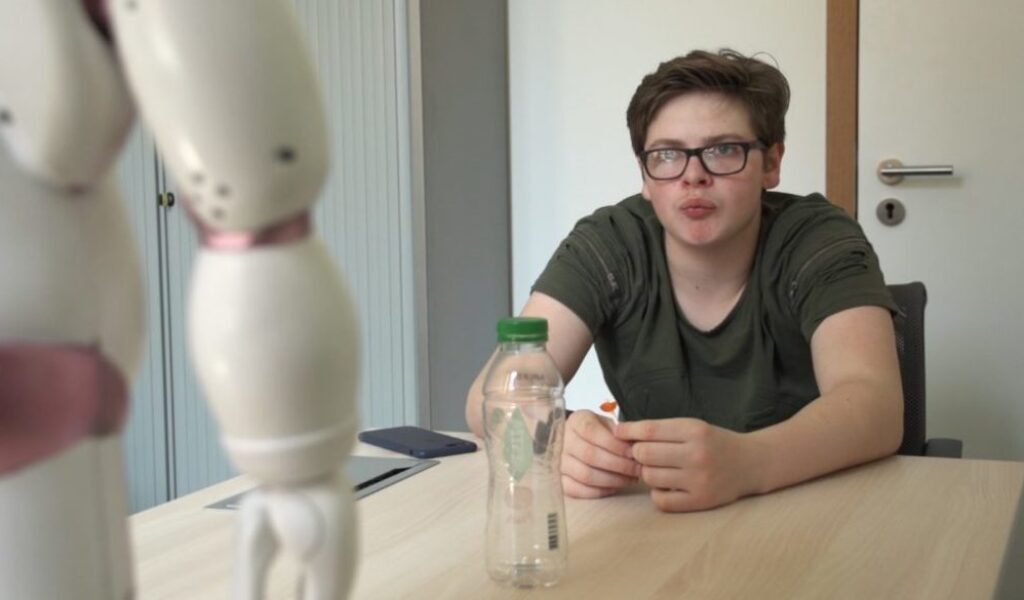Raising a child with autism makes tremendous demands on mothers and the family and no one knows this better than Solveig Ellefsen! This is the story of how Solveig found help for her son with Asperger’s.
What’s Wrong With My Child? And What’s Wrong With Us?
Her 2.5-year-old son Nils, as yet undiagnosed but displaying many of the classic symptoms of the condition, changed her life completely.
Solveig, a former global event manager, was working in a bank until giving up her full-time job to take care of Nils, says “there were no alarming signs in Nils when he was a baby. He was not sleeping very well but the rest was quite normal. He started talking early and he was extremely curious.”
“It was when he was 2.5 years when we felt that there was something wrong. It was impossible for him to follow the rules. Any change in the routine or plan was very difficult for him to handle. Also, he started to have head-banging and self-harm without feeling any pain. Whenever he was interacting with other children, instead of playing with them, he got easily frustrated and starting to hit other children.” she said.
Solveig’s mother in law, who was a former school teacher and director with experience in interactions with children with autism, started bringing up the idea of Nils having autism, however in that time even though they visited many doctors and psychologists, no one gave them neither a concrete diagnosis nor a plan to improve the child’s situation.
On top of all the challenges that came across, sending him to kindergarten was also a big issue. They had to change kindergartens quite often, because the teachers could not find a way to handle the child’s problems and frustrations. They got rejected from many centers, after Nils going there only for a couple of months.
“In that time, we as parents had a very hard time. We were always blaming ourselves for not being good parents and we have even been told by psychologists in the country that Nils’ behaviors were the reflection of our own behaviors with him. This guilt was more intensified because of the feedback coming from our friends, families and kindergarten teachers. Everyone was blaming us because they thought we have spoiled our child, as he was a single child and we were not doing our job as parents, teaching him the basic rules of behavior”.
Sufferings Seemed Endless And We Got Lost In A Misty Forest Of Misunderstandings, Pressures And Frustration
During all that time, Solveig and her husband tried a lot to find an explanation for Nils’ problems and hopefully a way to help him, but she says, “in that time autism was not yet a known condition. Everyone was just talking about ADHD or hyperactive children and how parents should be strict with children. They were just insisting on giving medication to Nils. But we wanted to understand what was going on! We couldn’t just accept medicating our child without understanding what we are treating at the first point.”
Meanwhile, they lost many friends. Solveig says “For our friends, it was not possible to cope with Nils’ situation and we decided to have less social interaction, to prevent some of the meltdowns for him and reduce the embracement and the judgment from people on us. We had to stick to a very routine plan, without any travels or even a slight change in our daily plan. Because anything which was out of this routine could flare up more frustration and meltdowns. The only thing that could comfort Nils in that time was our dog. He had a special interaction in the dog. But the rest of the world was just too much for him to handle.

The challenges of Solveig’s family became worse when Nils started the primary school. He was always impatient, frustrated and doing opposite of what was requested from him. For him, it was impossible to follow any rules and he was always refusing any authority. “The situation became very difficult for us, because in that time in the school system they wanted to put all children in the same box that was not fitting to Nils. There was no one in the school system that could find a way to help him. Their only feedback was that there is something wrong with this child and his parents.”
Solveig found herself in a very devastating situation. She had to change her job in the bank, with lots of responsibilities to a part-time job which was not fulfilling for her. At the same time, she was having everyday crisis with Nils’ school, teachers, others and her child, all of which caused her a serious burnout.
The Diagnosis Was A Blessing For Us And We Saw A Glimmer Of Hope
At the age of 11, trying another school system abroad, the school stopped accepting him. During a year out of the school system, the parents were asked to go through some sort of school procedure investigation, to find out what was going on with him. The parents were then referred to the Foundation Autism Luxembourg (FAL) and there they did multiple diagnostic tests, including the autism diagnostic test, IQ test and many more. Three months later in December 2015, when Nils was 11 years old, finally they had the diagnosis. Their son had Asperger’s!
“It may not come into many people’s mind, but the diagnosis was a blessing for us. By knowing what is going on with Nils, we could finally see the whole picture. We would not think anymore if he was crazy or spoiled and we didn’t have the feeling of guilt of being horrible parents. We knew what the problem was and we could finally focus on finding the solution.” Solveig says.
“We attended multiple meetings in FAL, getting information about Asperger’s, it’s symptoms and how it can be handled and finally started medication. Also, beside the normal school, Nils started attending a special class, 3 times per week in the afternoons. They allocated a shadow teacher who could assist him during the school time as well.”
Nils had to cope with the delay he had in the school coming from all years of back and forth with different schools and he started educating himself on everything using YouTube. In the future, he wants to go to an English-speaking school or university. That’s why he started using music and TV series to learn English and unbelievably one year after, without having any teacher or class he was able to communicate perfectly in English.
During the years after having the diagnosis, Solveig regained all her power to rebuild herself and overcome the burnout and negative effects of all those years of being overwhelmed with Nils’ unknown situation and used meditation and positive thinking to make herself a brand new person who is stronger and can be a good role model and supporter for Nils.
“I wanted to show Nils that everything is possible and if he wants, he can always move toward being better. I tried to push myself to be stronger, to be able to support my son and also, I tried to push him all the time that even though he has Asperger’s, it doesn’t mean that he cannot learn or grow. Nils’ father also supported him all the time and tried to help him to be stronger and empowered ” Solveig says.
QTrobot, The Robot Who Made A Difference In Nils’ Social Skills
One of the breakthroughs for Solveig was the opportunity to train Nils with a little robot, teaching emotions to children with autism.
“We always wanted to get more help for him from professionals and psychologists, but he really didn’t like to go to therapy, until we heard from Foundation Autism Luxembourg that the University of Luxembourg is offering emotional training sessions using a little robot called QTrobot. I immediately contacted the researcher responsible for the project and asked many questions about the training. Then I told my son about the opportunity.”
At the beginning, the session with the robot was a bit easy for Nils and he said “Mommy, I already know what the robot wants to teach”, but the researcher doing the experiments assured them that in the next sessions the skills would become more advanced and complex, so they kept attending the sessions.
“All in all, we had 10 sessions. The 1st and the last session were for the purpose of the evaluation and making sure about the Asperger’s diagnosis and also to see how things change after the multiple sessions with the robot. Then during the actual training, the robot taught him about recognizing emotions through facial expressions, body language and the voice. It also taught about how to handle his emotions and help himself to feel better.”

Solveig says “Now that the sessions are over, there are huge changes in Nils and I am sure they happened because of the training with the QTrobot. Before Nils would never talk about his feelings and all the times if he had a feeling, he couldn’t identify why he felt that way. Now he is very open about talking about himself and he can now express the reasons behind his emotions. Before whenever he felt frustrated, he couldn’t identify what was the reason and therefore he couldn’t find any way to help himself.”
“Also, since he has done this training he is even more aware of other people’s emotions and feelings. He tries to communicate more and now for the first time in his life, he has people who he considers as friends and he gets invitations to parties and birthdays which make him feel totally different from before. These changes are amazing and unbelievable! ”
Now he has more empathy and tries to support other people. He always asks me, “mommy my friend has this problem. How I can advise her and help her to feel better?!”
Before he was constantly getting bullied in the school and getting emotionally harassed by classmates. But now he always says that because I have gone through this experiment with QTrobot, I know what to do and I want to help other people and show them that they can change their relationships and find new friends.

It was just last March 2018, that Solveig published her 1st book, The Inner Sun Path to Happiness: A journey to rebuild yourself with healthy life-changing tools. Solveig dedicated her book to Nils as the inspiration of all the ideas in the book and explains her book as tips for people who are experiencing a complete burnout and they need a complete change in the way that they live. She wants to inspire others with this book considered as a tool-kit of 365 tips and hints of her own experience, and tell them that the negative can always be turned into something positive and that it’s never too late to change. Never ever giving up is the only advice she would love to give to other parents facing autism with their children. The book is now available on Amazon.fr
Helped a son with asperger – could QTrobot help my child, too?
QTrobot has been scientifically proven to help children with ASD or SEN to easier learn new skills. Are you interested to hear more about QTrobot and discuss how it could be helpful in your child’s learning process? You can book a free live demo with our team of specialists to discuss more.





